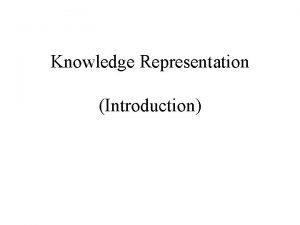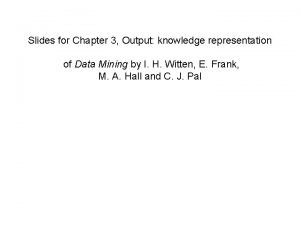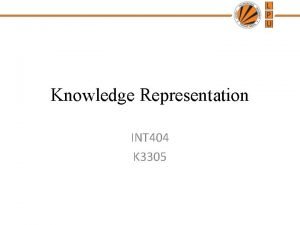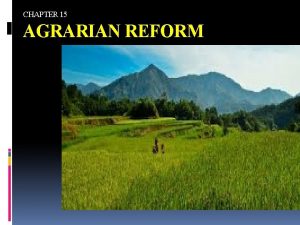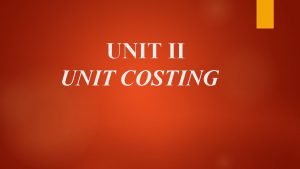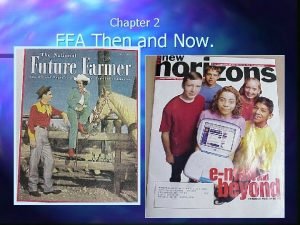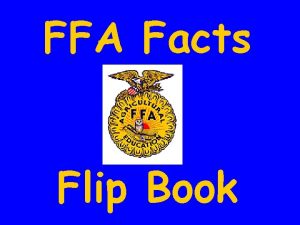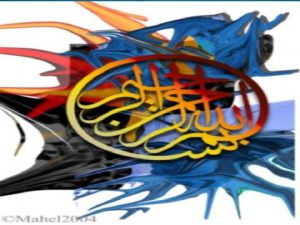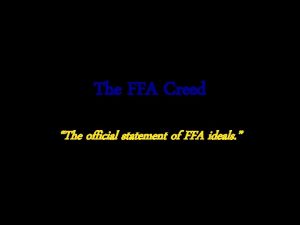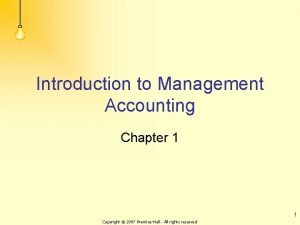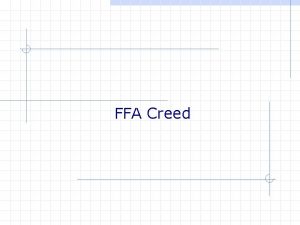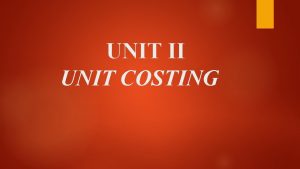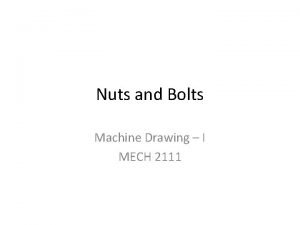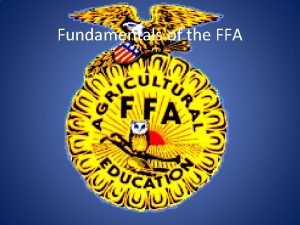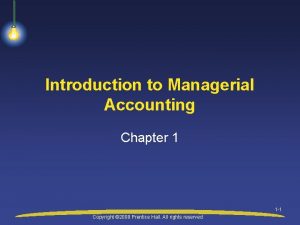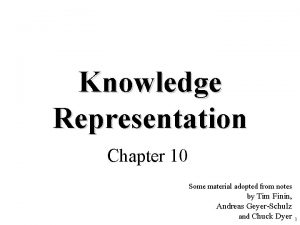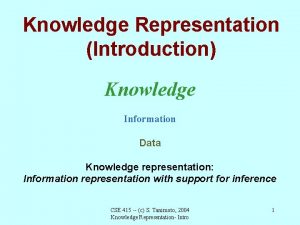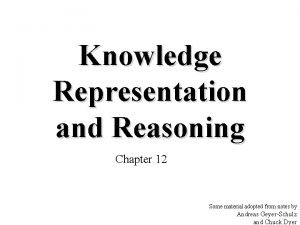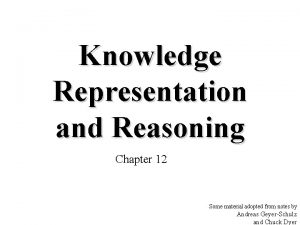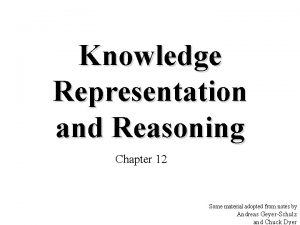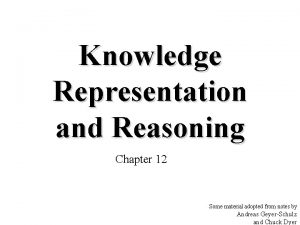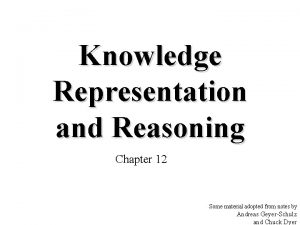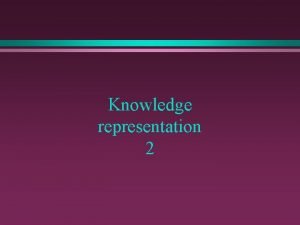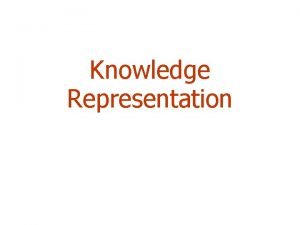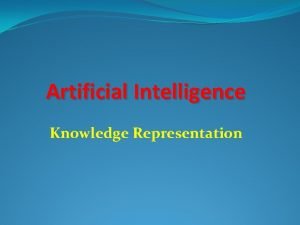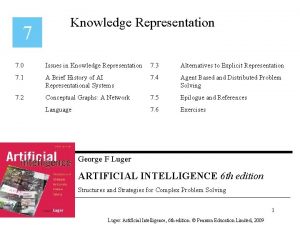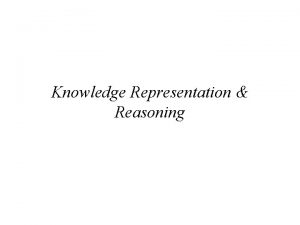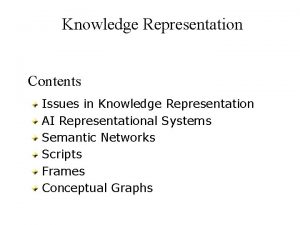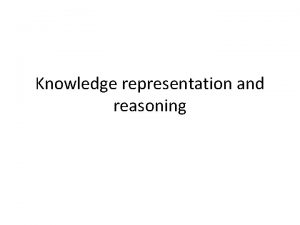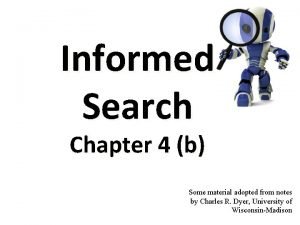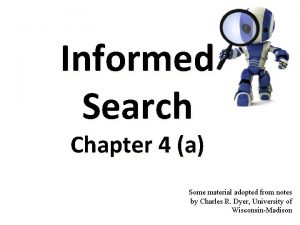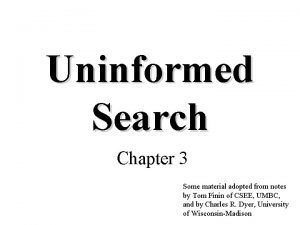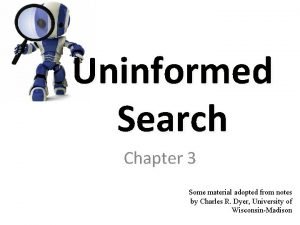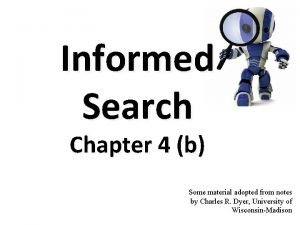Knowledge Representation Chapter 12 Some material adopted from































- Slides: 31

Knowledge Representation Chapter 12 Some material adopted from notes by Tim Finin, Marie des. Jardins Andreas Geyer-Schulz, and Chuck Dyer 1

Introduction • Real knowledge representation and reasoning systems come in several major varieties. • They all based on FOL but departing from it in different ways • They differ in their intended use, degree of formal semantics, expressive power, practical considerations, features, limitations, etc. • Some major families of reasoning systems are – – – – – Theorem provers Logic programming languages Rule-based or production systems Semantic networks Frame-based representation languages Description logics Databases (deductive, relational, object-oriented, etc. ) Constraint reasoning systems Truth maintenance systems 2

Production Systems (forward-chaining) • The notion of a “production system” was invented in 1943 by Post to describe re-write rules for symbol strings • Used as the basis for many rule-based expert systems • Most widely used KB formulation in practice • A production is a rule of the form: C 1, C 2, … Cn => A 1 A 2 …Am Left hand side (LHS) Conditions/antecedents Condition which must hold before the rule can be applied Right hand side (RHS) Conclusions/consequences Actions to be performed or conclusions to be drawn when the rule is applied 3

Three Basic Components of PS • Rule Base – (Un)ordered set of user-defined "if-then" rules. – Form of rules: if P 1 ^. . . ^ Pm then A 1, . . . , An – the Pi’s are conditions (often facts) that determine when rule is applicable. – Actions can add or delete facts from the Working Memory. – Example rule (in CLIPS format) (defrule determine-gas-level (working-state engine does-not-start) (rotation-state engine rotates) (maintenance-state engine recent) => (assert (repair "Add gas. "))) 4

• Working Memory (WM) -- A set of "facts“, represented as literals, defining what's known to be true about the world – Often in the form of “flat tuples” (similar to ground predicates), e. g. , (age Fred 45) – WM initially contains case specific data (not those facts that are always true in the world) – Inference may add/delete fact from WM – WM will be cleared when a case is finished • Inference Engine -- Procedure for inferring changes (additions and deletions) to Working Memory. – Can be both forward and backward chaining – Usually a cycle of three phases: match, conflict resolution, and action, (in that order) 5

Basic Inference Procedure While changes are made to Working Memory do: • Match the current WM with the rule-base – Construct the Conflict Set -- the set of all possible (rule, facts) pairs where rule is from the rule-base, facts from WM that unify with the conditional part (i. e. , LHS) of the rule. • Conflict Resolution: Instead of trying all applicable rules in the Conflict set, select one from the Conflict Set for execution. (depth-first) • Act/fire: Execute the actions associated with the conclusion part of the selected rule, after making variable substitutions determined by unification during match phase • Stop when conflict resolution fails to returns any (rule, facts) pair 6

Conflict Resolution Strategies • Refraction – A rule can only be used once with the same set of facts in WM. This strategy prevents firing a single rule with the same facts over and over again (avoiding loops) • Recency – Use rules that match the facts that were added most recently to WM, providing a kind of "focus of attention" strategy. • Specificity – Use the most specific rule, – If one rule's LHS is a superset of the LHS of a second rule, then the first one is more specific – If one rule's LHS implies the LHS of a second rule, then the first one is more specific • Explicit priorities – E. g. , select rules by their pre-defined order/priority • Precedence of strategies 7

• Example – R 1: P(x) => Q(x); R 2: Q(y) => S(y); WM = {P(a), P(b)} conflict set: {(R 1, P(a)), (R 1, P(b))} by rule order: apply R 1 on P(a); WM = {Q(a), P(b)} conflict set: {(R 2, Q(a)), (R 1, P(b))} by recency: apply R 2 on Q(a) WM = {S(a), Q(a), P(b)} conflict set: {(R 2, Q(a)), (R 1, P(b))} by refraction, apply R 1 on P(b): WM = {Q(b), S(a), Q(a), P(b)} conflict set: {(R 2, Q(b)), (R 2, Q(a)), (R 1, P(b))} by recency, apply R 2 on P(b): WM = {S(b), Q(b), S(a), Q(a), P(b)} 8

• Example – Specificity R 1: bird(x) => fly(x) R 2: penguin(z) => bird(z) R 3: penguin(y) => ~fly(y) WM={bird(tweedy), penguin(tweedy)} R 3 is more specific than R 1 because according to R 2, penguin(x) implies bird(x) 9

Default Reasoning • Reasoning that draws a plausible inference on the basis of less than conclusive evidence in the absence of information to the contrary – If WM = {bird(tweedy)}, then by default, we can conclude that fly(tweedy) – When also know that penguin(tweedy), then we should change the conclusion to ~fly(tweedy) – Bird(x) => fly(x) is a default rule (true in general, in most cases, almost) – Default reasoning is thus non-monotonic – Formal study of default reasons: default logic (Reiter), nonmonotonic logic (Mc. Dermott), circumscription (Mc. Carthy) one conclusion: default reasoning is totally undecidable – Production system can handle simple default reasoning • By specificity: default rules are less specific • By rule priority: put default rules at the bottom of the rule base • Retract default conclusion (e. g. , fly(tweedy)) is complicated 10

Other Issues • PS can work in backward chaining mode – Match RHS with the goal statement to generate subgoals – Mycin: an expert system for diagnosing blood infectious diseases • Expert system sell – A rule-based system with empty rule base – Contains data structure, inference procedures, AND user interface to help encode domain knowledge – Emycin (backward chaining) from Stanford U – OPP 5 (forward chaining) from CMU and its descendents CLIPS, Jess. • Metarules – Rules about rules – Specify under what conditions a set of rules can or cannot apply – For large, complex PS • Consistency check of the rule-base is crucial (as in FOL) • Uncertainty in PS (to be discussed later) 11

Comparing PS and FOL • Advantages – Simplicity (both KR language and inference), – Inference more efficient – Modularity of knowledge (rules are considered, to a degree, independent of each other), easy to maintain and update – Similar to the way humans express their knowledge in many domains – Can handle simple default reasoning • Disadvantages – No clearly defined semantics (may derive incorrect conclusions) – Inference is not complete (mainly due to the depth-first procedure) – Inference is sensitive to rule order, which may have unpredictable side effects – Less expressive (may not be suitable to some applications) • No explicit structure among pieces of knowledge in both FOL (a un-ordered set of clauses) and PS (a list of rules) 12

Structural Representations • Semantic networks • Frame systems • Description logic • Semantic Web 13

Semantic Networks • Structured representations (semantic networks and frame systems) – Put structures into KB (capture the interrelations between pieces of knowledge – Center around object/classes – More for what it is than what to do, typically for taxonomical K • History of semantic networks (Quillian, 1968) – To represent semantics of natural language words by dictionary-like definitions in a graphic form – Defining the meaning of a word in terms of its relations with other words – Semantic networks were very popular in the 60’s and 70’s and enjoy a much more limited use today. – The graphical depiction associated with a semantic network is a big reason for their popularity. – Recent Semantic Web is an application of SN to WWW 14

machine is a airplane used for move cargo used for move people can do pilot fly operated by is a pilot Boeing 747 – Nodes for words – Directed links for relations/associations between words • Each link has its own meaning – You know the meaning (semantics) of a word if you know the meaning of all nodes that are used to define that word and the meaning of the associated links – Otherwise, follow the links to the definitions of related words 15

Semantic Networks • A semantic (or associative) network is a simple representation scheme which uses a graph of labeled nodes and labeled, directed arcs to encode knowledge. – – – Labeled nodes: objects/classes/concepts. Labeled links: relations/associations between nodes Labels define the semantics of nodes and links Large # of node labels (there are many distinct objects/classes) Small # of link labels (types of associations can be merged into a few) E. g. buy, sale, give, steal, confiscation, etc. , can all be represented as a single relation of “transfer ownership” between recipient and donor – Usually used to represent static, taxonomic, concept dictionaries • Semantic networks are typically used with a special set of accessing procedures which perform “reasoning” – e. g. , inheritance of values and relationships • often much less expressive than other KR formalisms 16

Nodes and Arcs • Nodes denote objects/classes • arcs define binary relationships between objects. Sue age mother john wi fe hus b and 34 age 5 father Max Subject-predicate-object triples: mother(john, sue) age(john, 5) wife(sue, max) age(sue, 34). . . 17

Reification • Non-binary relationships can be represented by “turning the relationship into an object” • This is an example of what logicians call “reification” – reify v : consider an abstract concept to be real • We might want to represent the generic “give” event as a relation involving three things: a giver, a recipient and an object, give(john, mary, book 32) give recipient mary giver object john book 32 18

ISA hierarchy • The ISA (is a) or AKO (a kind of) relation is often used to link a class and its superclass. • And sometimes to link an instance and it’s class. • Some links (e. g. has. Part) are inherited along ISA paths. • The semantics of a semantic net can be relatively informal or very formal Animal Bird isa has. Part isa Wings Robin isa – often defined at the implementation level Rusty Red 19

Individuals and Classes Genus • Many semantic networks distinguish – nodes representing individuals and those representing classes – the “subclass” relation from the “instance-of” relation Animal subclass Bird instance has. Part subclass instance Rusty Wing Robin instance Red 20

Inference by Inheritance • One of the main types of reasoning done in a semantic net is the inheritance of values (properties) along the subclass and instance links. • Semantic Networks differ in how they handle the case of inheriting multiple different values. – All possible properties are inherited – Only the “lowest” value or values are inherited 22

Multiple inheritance • A node can have any number of superclasses that contain it, enabling a node to inherit properties from multiple "parent" nodes and their ancestors in the network. • Conflict or inconsistent properties can be inherited from different ancestors • Rules are used to determine inheritance in such "tangled" networks where multiple inheritance is allowed: – if X A B and both A and B have property P (possibly with different variable instantiations), then X inherits A’s property P instance (closer ancestors override far away ones). – If X A and X B but neither A B nor B A and both A and B have property P with different and inconsistent values, then X will not inherit property P at all; or X will present both instances of P (from A and B) to the user 23

Nixon Diamond • This was the classic example circa 1980. Person subclass Republican pacifist FALSE TRUE pacifist Quaker instance Nexon 24

Exceptions in ISA hierarchy • Properties of a class are often default in nature (there are exceptions to these associations for some subclasses/instances) • Closer ancestors (more specific) overriding far way ones (more general) Mammal 4 isa Human Bob • Use explicit inhibition links to prevent inheriting some properties has-legs bird isa has-legs can-do 2 Fly isa penguin isa Tweedy Inhibition link 25

From Semantic Nets to Frames • Semantic networks morphed into Frame Representation Languages in the 70’s and 80’s. • A Frame is a lot like the notion of an object in OOP, but has more meta-data. • A frame represents a stereotypical/expected/default view of an object • Frame system can be viewed as adding additional structures into semantic network, a frame includes the object node and all other nodes which directly related to that object, organized in a record like structure • A frame has a set of slots, each represents a relation to another frame (or value). • A slot has one or more facets, each represents some aspect of the relation 26

Facets • A slot in a frame holds more than a value. • Other facets might include: – current fillers (e. g. , values) – default fillers – minimum and maximum number of fillers – type restriction on fillers (usually expressed as another frame object) – attached procedures (if-needed, if-added, if-removed) – salience measure – attached constraints or axioms – pointer or name of another frame 27

28

Other issues • Procedural attachment – In early time, AI community was against procedural approach and stress declarative KR – Procedures came back to KB systems when frame systems were developed, and later also adopted by some production systems (action can be a call to a procedure) – It is not called by a central control, but triggered by activities in the frame system – When an attached procedure can be triggered? if-added: when a new value is added to one of the slot in the frame if-needed: when the value of this slot is needed if-updated: when value(s) that are parameters of this procedure is changed 29

Other issues • Objects with multiple perspectives – An object or a class may be associated with different sets of properties when viewed from different perspectives. – A passenger in an airline reservation system can be viewed as • A traveler, whose frame should include slots such as the date of the travel, departure/arrive airport; departure/arrive time, ect. • A customer, whose frame should include slots such as fare amount credit card number and expiration date frequent flier’s id, etc. – Both traveler frame and customer frame should be children of the passenger frame, which has slots for properties not specific to each perspective. They may include name, age, address, phone number, etc. of that person 30

• Description logic – There is a family of Frame-like KR systems with a formal semantics. E. g. , KL-ONE, LOOM, Classic, … – Subset of FOL, particularly for describing categories • Concepts for classes/categories • Roles for relations between classes e. g. , Bachelor = And(unmarried, Adult, Male) in DL Bachelor(x) Unmarried(x) ^ Adult(x) ^ Male(x) in FOL – Inference: • Subsumption: B subsumes A if A is an instant or a subclass of B • Classification: x is classified in A if A is the most specific subsumer – Keep the language simple, so that all inference can be done in polynomial time (in the number of objects) • ensuring tractability of inference 31

Typical DL Architecture father= man ∏ E has. child X human=mammal ∏ biped … Knowledge Base Definitions of Terminology TBox Assertions about individuals ABox john = human ∏ father john has. child mary Interface Inference System The division into TBox and ABox doesn’t have a logical significance, but is made for conceptual and implementation convenience. 32
 Script in knowledge representation
Script in knowledge representation Representing input data and output knowledge
Representing input data and output knowledge Int 404
Int 404 Difference between normal loss and abnormal loss
Difference between normal loss and abnormal loss Author of the ffa creed
Author of the ffa creed Republic act no 55 agrarian reform
Republic act no 55 agrarian reform Meaning of unit costing
Meaning of unit costing Public law 740 passed by congress
Public law 740 passed by congress Ffa colors meaning
Ffa colors meaning Unit dose dispensing definition
Unit dose dispensing definition Curriculum development process in pakistan
Curriculum development process in pakistan Old ffa creed
Old ffa creed The institute of management accountants adopted the ______.
The institute of management accountants adopted the ______. 2 paragraph of the ffa creed
2 paragraph of the ffa creed The method of unit costing is adopted by
The method of unit costing is adopted by Screw thread profile adopted by bis
Screw thread profile adopted by bis When was the ffa creed adopted and amended
When was the ffa creed adopted and amended The institute of management accountants adopted the ______.
The institute of management accountants adopted the ______. They say sometimes you win some
They say sometimes you win some They say it only takes a little faith to move a mountain
They say it only takes a little faith to move a mountain Cake countable or uncountable
Cake countable or uncountable Contact force
Contact force Fire and ice diamante poem
Fire and ice diamante poem Some say the world will end in fire some say in ice
Some say the world will end in fire some say in ice Some may trust in horses
Some may trust in horses Profile tolerance symbol
Profile tolerance symbol Usage variance formula
Usage variance formula Material culture and nonmaterial culture
Material culture and nonmaterial culture Non material culture examples
Non material culture examples All groups create norms to enforce their cultural values.
All groups create norms to enforce their cultural values. Usefull and harmfull
Usefull and harmfull Personal and shared knowledge
Personal and shared knowledge
